Third Party Confirmation Letter
Subject: Third-Party Confirmation Letter
Dear [Recipient's Name],
I am writing this letter to provide third-party confirmation regarding [Name of Individual/Company] and their involvement in [specific project or activity]. I have had direct and ongoing professional interaction with [Name of Individual/Company], and I am pleased to offer my confirmation and endorsement.
[Describe your relationship with the individual/company and the context in which you are providing the confirmation. Include details such as the duration of your association, the nature of the project/activity, and the individual/company's role and contributions.]
Based on my personal experience and observations, I can confidently confirm the following:
1. [Specify the individual's/company's skills, competencies, or qualifications relevant to the project/activity. Provide specific examples or instances that showcase their expertise.]
2. [Highlight the individual's/company's reliability, professionalism, and ability to meet deadlines and deliver high-quality work. Share any notable achievements or positive outcomes resulting from their involvement.]
3. [Discuss any additional positive attributes, such as strong work ethic, effective communication skills, ability to work well in a team, or any other notable strengths.]
4. [Include any other relevant information or details that further support your confirmation and endorsement of the individual/company.]
Please note that this letter serves as my voluntary and unbiased opinion based on my professional experience and interactions. I have no personal or financial interest in providing this confirmation.
Should you require any additional information or have further questions, please do not hesitate to contact me using the details provided above.
Thank you for considering my confirmation of [Name of Individual/Company]. I believe that their skills and capabilities make them a valuable asset to any project or endeavor.
Yours sincerely,
[Your Name]
Formal Third Party Confirmation Letter
Subject: Confirmation of [Specific Matter]
Dear [Recipient Name],
We are writing to confirm on behalf of [Company/Individual Name] regarding [specific matter]. As a third party, we verify that the information provided is accurate and authentic to the best of our knowledge.
Please consider this letter as formal confirmation for your records.
Sincerely,
[Sender Name]
[Title/Position]
[Company Name]
Informal Third Party Confirmation Email
Subject: Confirmation Regarding [Matter]
Hi [Recipient Name],
Just reaching out to confirm that [Company/Individual Name] has [done/approved] [specific matter]. We are happy to verify this information as requested.
Let us know if you need any more details!
Best regards,
[Sender Name]
Third Party Verification Letter for Financial Purposes
Subject: Verification of Financial Information
To Whom It May Concern,
This letter serves as confirmation of the financial details of [Company/Individual Name] for [purpose, e.g., loan, account verification]. Based on our records, all information provided is true and accurate as of [date].
Should you require further clarification, please contact us.
Sincerely,
[Sender Name]
[Title/Position]
[Company Name]
Third Party Confirmation for Employment Verification
Subject: Employment Confirmation of [Employee Name]
Dear [Recipient Name],
We confirm that [Employee Name] has been employed with [Company Name] as a [Position] from [Start Date] to [End Date or Present]. This letter serves as a third-party verification of employment details provided by the employee.
If further details are required, please do not hesitate to contact us.
Sincerely,
[Sender Name]
[Title/Position]
[Company Name]
Provisional Third Party Confirmation Letter
Subject: Provisional Confirmation of [Matter]
Dear [Recipient Name],
As requested, we provide provisional confirmation regarding [specific matter] on behalf of [Company/Individual Name]. Please note that this confirmation is based on information currently available and may be subject to verification.
We are available to provide final confirmation once all data is reviewed.
Best regards,
[Sender Name]
[Title/Position]
Quick Third Party Confirmation Email
Subject: Confirmation of [Matter]
Dear [Recipient Name],
We confirm that [Company/Individual Name] has [completed/approved] [specific matter] as requested. This email serves as formal confirmation for your records.
Regards,
[Sender Name]
Official Third Party Confirmation for Legal Purposes
Subject: Legal Confirmation of [Matter]
To Whom It May Concern,
We hereby confirm, as an authorized third party, that [Company/Individual Name] has complied with [specific legal matter]. This confirmation is provided based on our review of the relevant documents and information.
Please retain this letter for legal reference.
Sincerely,
[Sender Name]
[Title/Position]
[Company Name]
What is a Third Party Confirmation Letter and Why You Need It
A Third Party Confirmation Letter is a document written by an entity or individual not directly involved in a transaction or matter to confirm certain facts or information.
Purpose:
- Validate information for legal, financial, or administrative purposes.
- Provide credible verification from a neutral source.
- Help the recipient trust the accuracy of the information.
Who Should Send a Third Party Confirmation Letter
- Auditors or accounting firms verifying financial details.
- Legal representatives confirming compliance or contractual details.
- HR departments confirming employment records.
- Business partners or organizations acting as neutral verifiers.
Whom Should the Third Party Confirmation Letter Be Addressed To
- Banks or financial institutions for verification.
- Employers or HR departments requesting employment verification.
- Legal authorities requiring formal confirmation.
- Any individual or entity requesting independent verification.
When to Send a Third Party Confirmation Letter
- During financial audits or loan applications.
- When verifying employment or professional records.
- As part of legal documentation or court submissions.
- For compliance purposes in contracts or agreements.
How to Write and Send a Third Party Confirmation Letter
- Start with a clear subject indicating the confirmation purpose.
- Introduce yourself and explain your relationship as a third party.
- Provide accurate and concise details being confirmed.
- Include dates, names, and any relevant identifiers.
- Close with contact information for further verification.
- Send via email for speed or printed letter for formal/legal purposes.
Formatting Guidelines for Third Party Confirmation Letters
- Length: 1 page maximum.
- Tone: Professional, neutral, and factual.
- Style: Clear and direct; avoid ambiguous language.
- Structure: Subject, greeting, statement of confirmation, details, closing, signature.
- Optional: Attach supporting documentation if needed.
Requirements and Prerequisites Before Sending
- Verify the accuracy of the information being confirmed.
- Obtain authorization if confirming on behalf of an organization.
- Collect supporting documents or evidence.
- Ensure compliance with privacy and confidentiality rules.
After Sending a Third Party Confirmation Letter
- Confirm receipt by the requesting party.
- Be prepared to answer follow-up questions or provide additional evidence.
- Maintain a copy for your records and organizational compliance.
Common Mistakes to Avoid
- Confirming information without proper verification.
- Using vague or ambiguous language.
- Sending without authorization from your organization.
- Omitting essential details like dates, names, or identifiers.
- Failing to follow up with requested parties.
Key Elements and Structure of a Third Party Confirmation Letter
- Subject clearly stating the purpose of the letter.
- Greeting addressing the recipient.
- Statement confirming the specific matter or information.
- Details with factual accuracy, including dates and names.
- Closing statement with contact info.
- Signature and title of the confirming party.
- Optional attachments supporting the confirmation.
Tips and Best Practices
- Keep language neutral and professional.
- Provide clear evidence or references when possible.
- Use official letterhead or email signatures for credibility.
- Send in a timely manner to meet deadlines.
- Maintain confidentiality and compliance with regulations.
Compare and Contrast with Other Confirmation Letters
- Compared to self-confirmation: Third party adds credibility and neutrality.
- Compared to internal memos: Usually more formal and intended for external use.
- Alternative: Digital verification through certified platforms, though traditional letters remain standard in legal and financial contexts.
Does a Third Party Confirmation Letter Require Attestation or Authorization
- Often requires authorization from the confirming party’s organization.
- Legal or financial confirmations may require notarization or official stamps.
- Signature of a responsible officer enhances validity and acceptance.
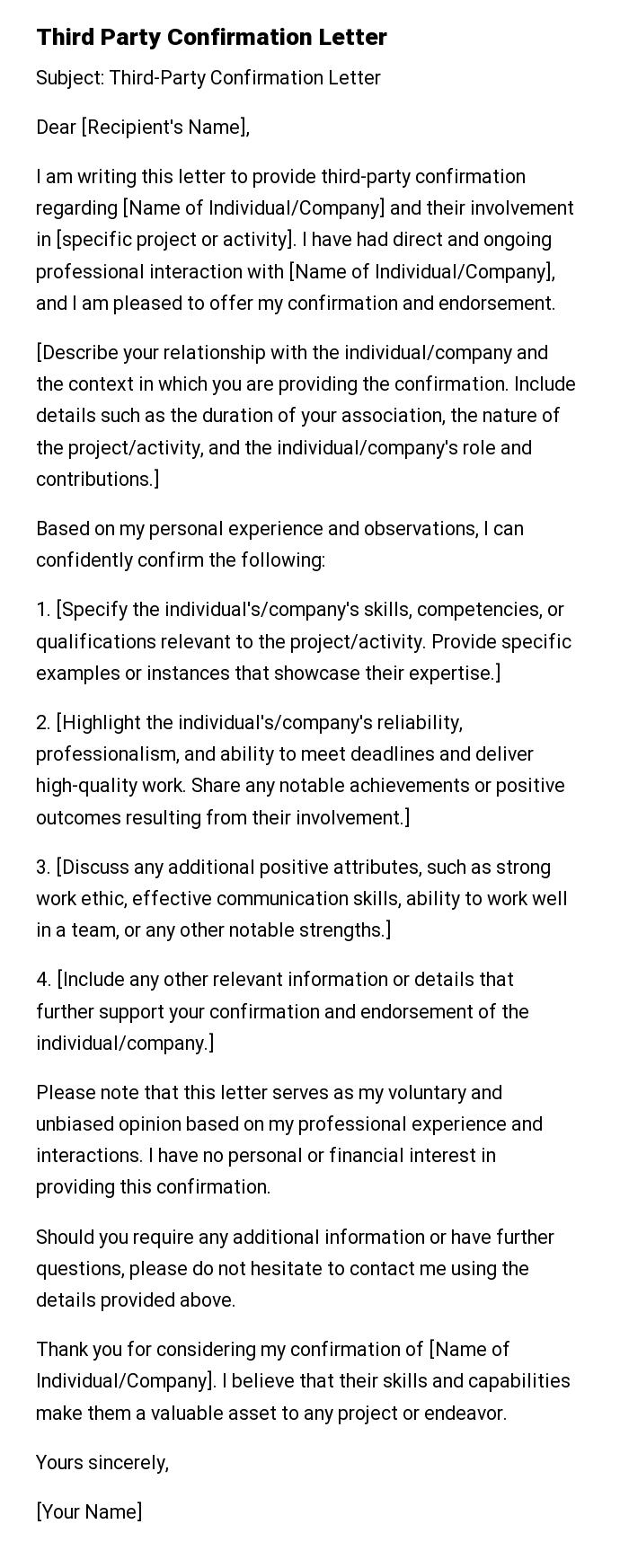
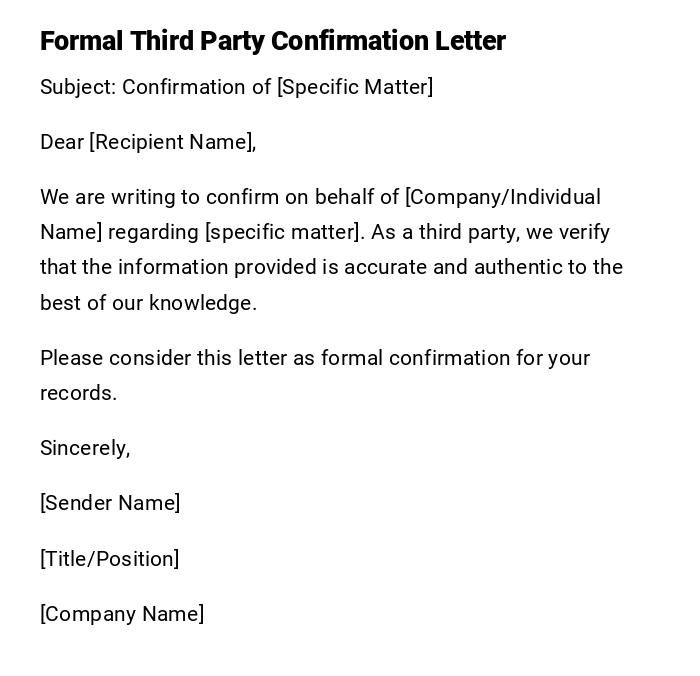
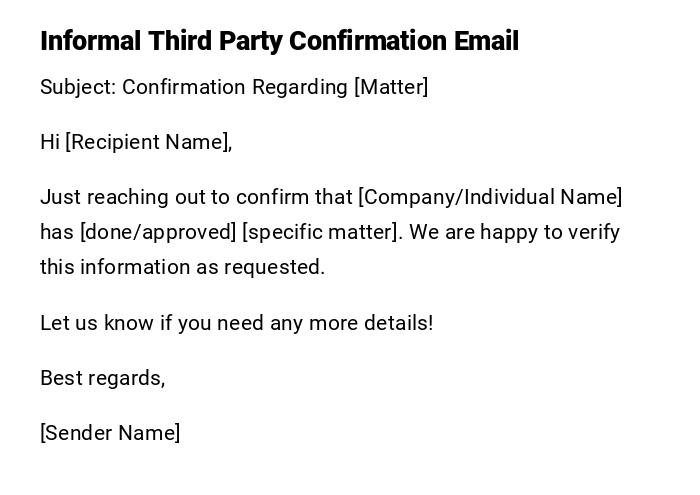
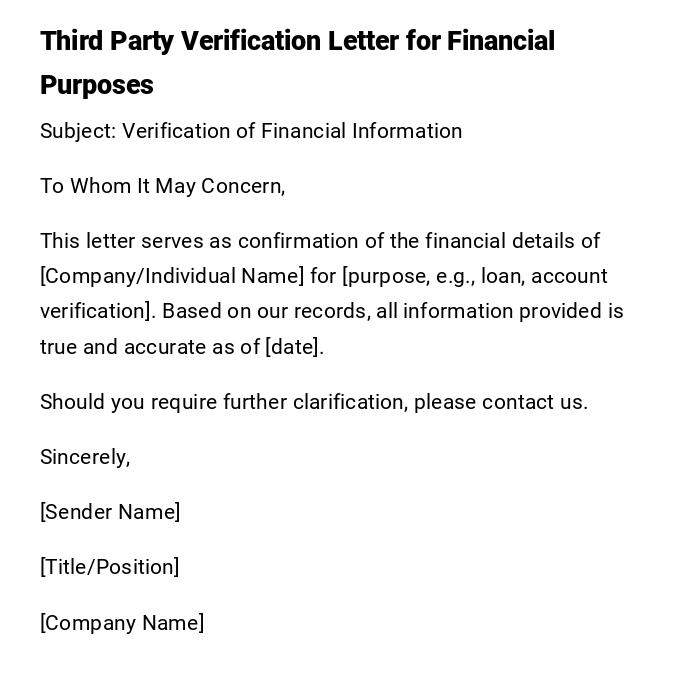
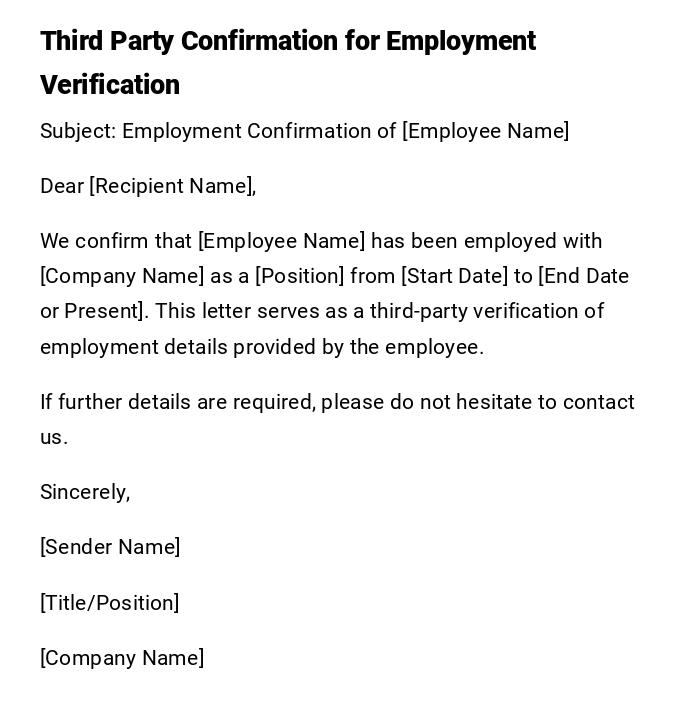
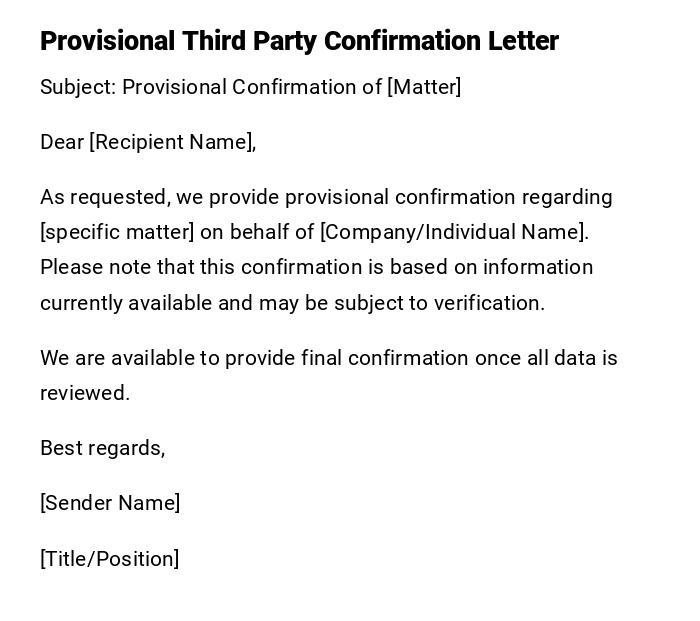
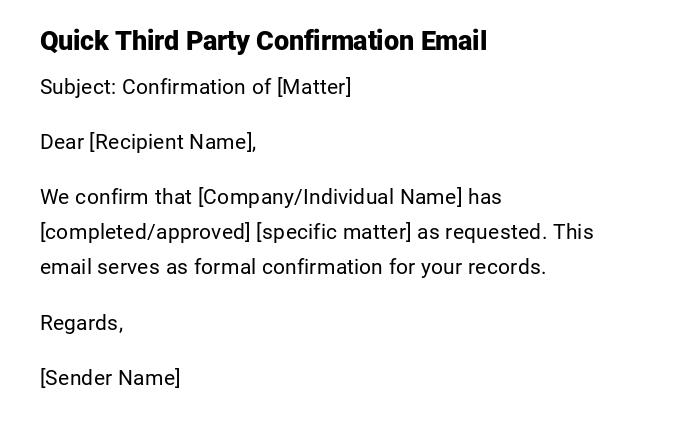
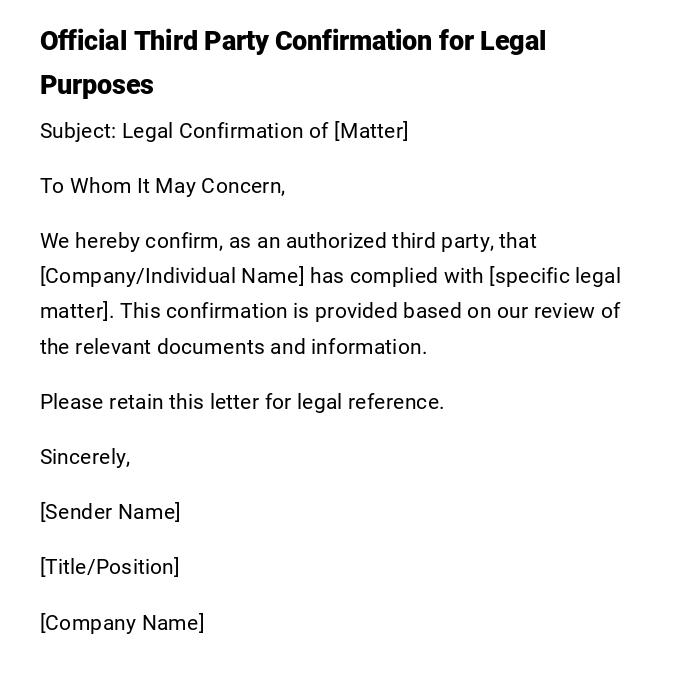

 Download Word Doc
Download Word Doc
 Download PDF
Download PDF